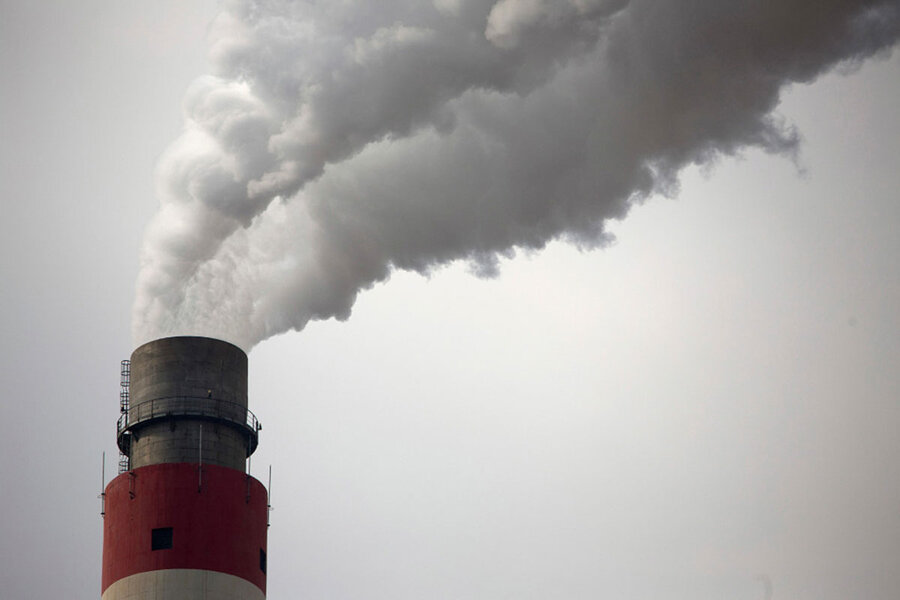Could a Moore's Law for carbon emissions halt climate change?
Loading...
"Two degrees Celsius."
That term is often bandied about in discussions of climate change. That's because experts cite the goal of preventing warming over 2 degrees Celsius above pre-industrial levels as being absolutely necessary to prevent catastrophic climate change.
But attempts to express how to reach that goal haven't been so clear or pithy, until a proposal published Thursday in the journal Science introduced a new term: "carbon law."
Like the 2-degree figure, those researchers also have a number that they say is key: half.
If global carbon emissions are halved each decade, nearly net-zero emissions will be achieved by 2050, according to the carbon law framework outlined in the paper. And, the scientists say, it's doable.
"The carbon law is an effort of translating what science says is necessary for us to do to deliver the Paris agreement for a safe climate future for humanity," lead author of the paper Johan Rockström, director of the Stockholm Resilience Centre at Stockholm University, explains in a phone interview with The Christian Science Monitor. "And the carbon law translates into halving the emissions of carbon dioxide every decade."
When Dr. Rockström and his colleagues dug into the numbers behind possible paths to achieving the 2-degree goal set in the Paris agreement, they realized that carbon dioxide emissions will need to go down quickly. According to their framework, which is inspired by the computer industry's Moore's Law, which predicts that the number of transistors in an integrated circuit will double every two years or so, the 40 billion metric tons (gigatons) of carbon dioxide being emitted each year must be halved to 20 gigatons by 2030, 10 gigatons by 2040, and 5 gigatons by 2050.
"It's simply putting dots along the very complex global science scenarios that takes us to Paris. It's just putting dots along the curve that can take us under 2 degrees Celsius," Rockström says.
This carbon law can be used at any scale, he points out. It isn't just for global emissions. Nations, cities, and companies can also use the guideline of halving emissions to build carbon-cutting plans. Even an individual person could apply this framework to their own personal carbon emissions.
But it's not just a framework. Rockström and his colleagues propose carbon pricing across the world that rises over the same period. As the scientists write in the paper: "In the 2020s, carbon pricing across the world must expand to cover all GHG emissions, starting at $50 per metric ton at least and exceeding $400 per ton by mid-century."
And the roadmap outlined by the team isn't just about cutting existing carbon sources. Coal and oil use would need to be phased out in exchange for renewable energy sources.
Renewable energy sources have already been doubling every five and a half years globally, Rockström says. Continuing that rate will mean that the entire energy sector could be decarbonized before the middle of the century. That has coal use ending around 2030 to 2035 and oil use ending around 2040 to 2045.
"That law, we hope, can become an incentive for innovation and a journey towards a more attractive and prosperous future," Rockström says.
Adil Najam, dean of the school of global studies at Boston University who was not involved in the paper, agrees with Rockström that this is a feasible path.
"We have the technology, we have the economic framework, we have the reduction in cost of the alternative energies, we have the range of different types of alternative energy, and we have the momentum that can make this happen," he says in a phone interview with the Monitor.
But, "although we have the ability to meet the challenge," Dr. Najam says, it now hinges on "whether we will pick that up and make that happen," as individuals and in motivating political will.
This may make limiting global temperature rise to no more than 2 degrees Celsius seem daunting, Najam says. But "I hope it will propel people into recognizing the gravity of the situation and the enormity of the effort that is required."
Charles Kolstad, an environmental economist at Stanford University, is less optimistic. "Carbon reduction is a tough nut to crack," he writes in an email to the Monitor. "I agree that we should be trying to reduce carbon emissions, and I support substantive action to that effect. But I don’t see how simply establishing a 'carbon law' of halving emissions every decade will accomplish anything."
Dr. Kolstad points to fears that the cost of shifting to a carbon-free economy will be great. "Until some country actually undertakes significant carbon reduction without impacting their standard of living, this uncertainty will persist," he predicts.
And it's not limited to a question of maintaining a standard of living, Kolstad says. For developing countries, like India and China, there is fear that any substantial changes to a carbon-reliant economy might derail growth, he says.
Rockström suggests that companies might lead the way in adopting the carbon law, as well as nations. If the top companies in many sectors adopt it as a business strategy and prove that such efforts can create jobs and enable growth, this could motivate political entities and individuals as well, he says.
"At the same time, it is fundamental to get individuals to start basically voting with their feet in terms of behavior and engagement," Rockström says. If individuals take on the carbon law, they could help sway companies and politicians to adopt it as well.
Although the carbon law roadmap is ambitious, Christiana Figueres, who was influential in brokering the Paris agreement as the then- climate chief of the United Nation, has given it her stamp of approval.
"I don't think it's wishful thinking. I think it's visionary thinking," she told Reuters.








